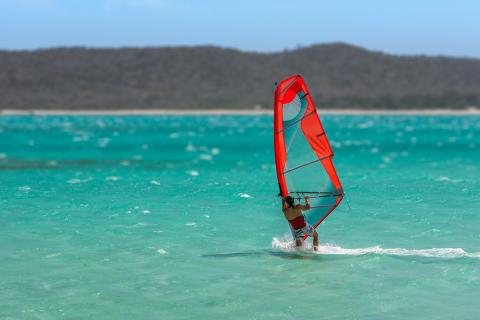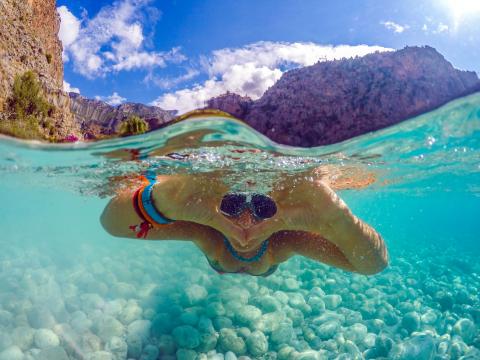Fethiye is the perfect launching pad to explore the many tourist attractions and things to do along Turkey's Turquoise Coast. This harborside town is in a prime position for heading out to the surrounding beaches or going inland to discover the crumbling remnants of this region's ancient Lycian culture. If it's all about location, Fethiye provides it all. The town itself is a prosperous but laid-back kind of place; just what you need to return to after a day's hectic sightseeing of mighty rock-cut tombs and mountain-top, Unesco-protected ruins or sunbathing bliss, boating, and paragliding action. Plan your trip with our list of the top things to do in Fethiye.
1. Lycian Sites: The Lycians ruled over this stretch of Turkey's coast from 200 BC, and Fethiye stands on the site of the important Lycian city of Telmessos. There are plenty of monuments scattered throughout the city, but the most famous is the rock-cut Tomb of Amyntas in the south of Fethiye. On Kaya Caddesi, as you walk up the hill towards the tomb, you can see Lycian sarcophagi along the way. More Lycian sarcophagi are also by the town hall in the city center.
2. Roman Theater: When the Romans conquered Turkey, they allowed the independently minded Lycians self-rule, but that didn't stop them making their own mark on the Lycian cities. Fethiye's small and only partially excavated theater was built in the 2nd century BC, when Telmessos had become part of Rome's Asia Minor dominion. It would have originally seated 6,000 spectators. Climb up to the top tier of seating for great views across town and over the sea beyond. The park opposite the theater is a good place to relax and seek some shade on a summer's day.
3. Fethiye Museum: It may be small, but Fethiye Museum is an excellent place to get a grip on Lycian history, especially if you're planning to head on to attractions such as Tlos and Letoön. Brilliant information panels clearly explain Lycian culture, and the exhibits of pottery, jewelry, and stele are beautifully displayed. The museum's pride and joy is the Trilingual Stele (inscribed with Lycian, ancient Greek, and Aramaic) found while excavating Letoön. This stone helped archaeologists to finally crack the Lycian language.
4. Ölüdeniz Lagoon: Turkey's most famous beach is 15 kilometers from Fethiye. The calm turquoise water, sheltered from the sea, with its white-sand beach rimmed by dense pine forest, is impossibly perfect, which is why people have been flocking here for years now. Some of Ölüdeniz's sheen has been shaken off over the past two decades, as package tourism arrived on the scene, but the lagoon area has not seen the construction development of other tourism hot spots, and the village attached to the lagoon is still a low-story unobtrusive affair. If you don't want to swim or sunbathe then the other big activity here is paragliding. Mt. Baba (Baba Dag) dominates the scenery inland, and paragliders launch themselves off the peak throughout the summer months. Even beginners can have a go with a tandem paragliding flight.
5. Kayaköy: Up until the 1920s, Kayaköy (ancient Karmylassos), eight kilometers from Fethiye, had a thriving mixed population of Greeks and Turks who had lived together for centuries. The 1923 Population Exchange changed all of that, uprooting ethnic Greeks across Turkey and sending them to live in Greece and making ethnic Turks who lived in Greece abandon their lives there. The exchange created heartbreak and much trauma among those who were made to leave, and the somber results of this are no better seen than in Kayaköy. The dilapidated, eerie stone village that snakes across the hillside here has been left to slowly decay since its Greek owners said goodbye. Among the ruins is the Katapongagia Church and Taxiarchis Church, which both still have some beautiful interior decoration.
6. Saklikent Gorge: This ravine, 30 kilometers from Fethiye, is cut deeply into the mountains of the Akdaglar Range. Most visitors come to trek the gorge, which has wooden boardwalks along part of the trail high above the river. The last section of the trail is reached by fording the swift-running river itself and then walking through the narrow fissure to the end. Cushion-strewn tea houses are beside the river here if you don't fancy walking through the freezing cold water. There are also canyoning and rafting trips along the river for the more actively inclined visitor.
7. Pinara: In the hills southeast of Fethiye, the ruins of the Lycian city of Pinara are chiefly interesting for their honeycombed cliff of more than 900 rock tombs and monolithic house tombs. The site was so inaccessible that the tomb-builders had to be lowered on stages secured with ropes. The beautiful scenery that surrounds the ruins is lushly stunning, especially around the theater area overlooked by snow-topped peaks and rimmed by verdant forest. This is one of the quieter Lycian sites in the area and rarely gets busy with tourists.
8. Letoon: This Unesco-protected ruin was an important Lycian religious center dedicated to the Greek goddess Leto who, according to local mythology, was banished to Lycia by Zeus' jealous wife Hera after an affair with the great Greek god. The three temples here are dedicated to Leto and her twin children by Zeus, Apollo and Artemis. The site is incredibly atmospheric and a wonderful accompaniment to a visit to Xanthos, the ancient capital of Lycia. In particular, check out the well-preserved mosaic in the floor of the Apollo temple.
9. Xanthos: Xanthos was the capital of ancient Lycia, sometimes called "the oldest republic in the world." This league of 20 cities was governed by a popular assembly and a president who ruled from Xanthos. The site is now protected by UNESCO. Although many of Xanthos' most beautiful monuments were taken to England in the 19th century, some fine mosaics are still in situ, and the theater, agora, and acropolis can still be seen. Beyond the Roman theater, to the left of the road, is the plinth that once held the Nereid Monument, an ionic temple with rich sculptural decoration (now displayed in the British Museum). To the right of the road is the Hellenistic city gate. The city walls, considerable stretches of which are still visible, probably date from the 3rd century BC.
10. Butterfly Valley: This lovely beach, secreted between two sharp cliffs, is home to the Jersey Tiger Butterfly. One of the joys of Butterfly Valley is that it is unreachable by road. You either have to trek here from Faralya village, high above on the cliff, or take a boat (during summer they leave a couple of times daily) from Ölüdeniz. Great hiking opportunities are in the lush forested gorge behind the beach, though most people are happy to just stretch out on the sand.













